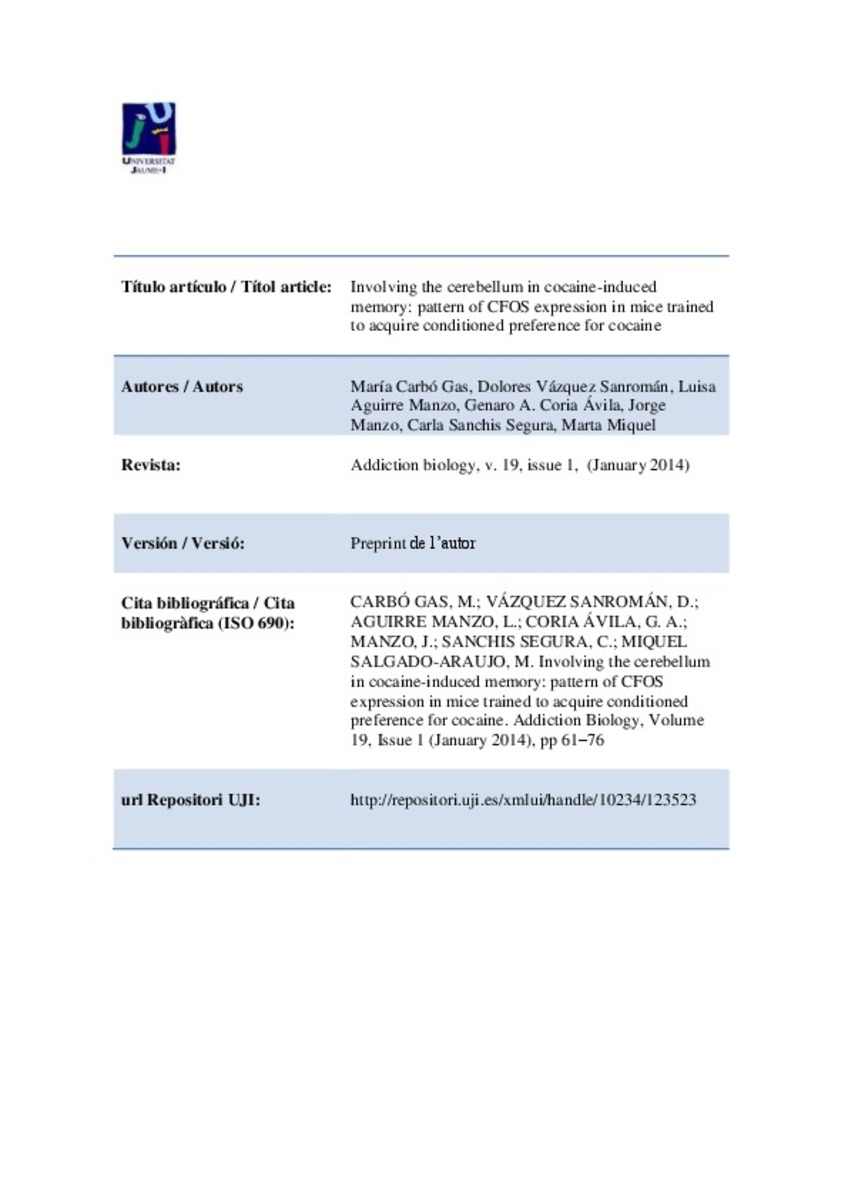Mostrar el registro sencillo del ítem
Involving the cerebellum in cocaine-induced memory: pattern of CFOS expression in mice trained to acquire conditioned preference for cocaine
| dc.contributor.author | Carbó Gas, María | |
| dc.contributor.author | Vázquez Sanromán, Dolores | |
| dc.contributor.author | Aguirre Manzo, Luisa | |
| dc.contributor.author | Coria Ávila, Genaro A. | |
| dc.contributor.author | Manzo, Jorge | |
| dc.contributor.author | Sanchis-Segura, Carla | |
| dc.contributor.author | MIQUEL, MARTA | |
| dc.date.accessioned | 2015-06-15T10:09:55Z | |
| dc.date.available | 2015-06-15T10:09:55Z | |
| dc.date.issued | 2014-01 | |
| dc.identifier.citation | CARBÓ GAS, M.; VÁZQUEZ SANROMÁN, D.; AGUIRRE MANZO, L.; CORIA ÁVILA, G. A.; MANZO, J.; SANCHIS SEGURA, C.; MIQUEL SALGADO-ARAUJO, M. Involving the cerebellum in cocaine-induced memory: pattern of CFOS expression in mice trained to acquire conditioned preference for cocaine. Addiction Biology, Volume 19, Issue 1 (January 2014), pp 61–76 | ca_CA |
| dc.identifier.uri | http://hdl.handle.net/10234/123523 | |
| dc.description.abstract | Because of its primary role in drug-seeking, consumption and addictive behaviour, there is a growing interest in identifying the neural circuits and molecular mechanisms underlying the formation, maintenance and retrieval of drug-related memories. Human studies, which focused on neuronal systems that store and control drug-conditioned memories, have found cerebellar activations during the retrieval of drug-associated cue memory. However, at the pre-clinical level, almost no attention has been paid to a possible role of the cerebellum in drug-related memories. In the present study, we ought to fill this gap by aiming to investigate the pattern of neuronal activation (as revealed by cFos expression) in different regions of the prefrontal cortex and cerebellum of mice trained to develop conditioned preference for an olfactory stimulus (CS+) paired with cocaine. Our results indicate that CS+ preference was directly associated with cFos expression in cells at the apical region of the granule cell layer of the cerebellar vermis; this relationship being more prominent in some specific lobules. Conversely, cFos+ immunostaining in other cerebellar regions seems to be unrelated to CS+ preference but to other aspects of the conditioning procedure. At the prefrontal cortex, cFos expression seemed to be related to cocaine administration rather than to its ability to establish conditioned preference. The present results suggest that as it has been observed in some clinical studies, the cerebellum might be an important and largely overlooked part of the neural circuits involved in generating, maintaining and/or retrieving drug memories. | ca_CA |
| dc.format.extent | 50 p. | ca_CA |
| dc.format.mimetype | application/pdf | ca_CA |
| dc.language.iso | eng | ca_CA |
| dc.publisher | Wiley | ca_CA |
| dc.relation.isPartOf | Addiction Biology, Volume 19, Issue 1 (January 2014) | ca_CA |
| dc.rights.uri | http://rightsstatements.org/vocab/CNE/1.0/ | * |
| dc.subject | Cerebellum | ca_CA |
| dc.subject | Cocaine | ca_CA |
| dc.subject | Conditioning | ca_CA |
| dc.subject | Mice | ca_CA |
| dc.subject | Preference | ca_CA |
| dc.subject | Vermis | ca_CA |
| dc.title | Involving the cerebellum in cocaine-induced memory: pattern of CFOS expression in mice trained to acquire conditioned preference for cocaine | ca_CA |
| dc.type | info:eu-repo/semantics/article | ca_CA |
| dc.identifier.doi | http://dx.doi.org/10.1111/adb.12042 | |
| dc.rights.accessRights | info:eu-repo/semantics/openAccess | ca_CA |
| dc.relation.publisherVersion | http://onlinelibrary.wiley.com/doi/10.1111/adb.12042/abstract | ca_CA |
| dc.type.version | info:eu-repo/semantics/submittedVersion | ca_CA |
Ficheros en el ítem
Este ítem aparece en la(s) siguiente(s) colección(ones)
-
PSB_Articles [1294]
Articles de publicacions periòdiques







